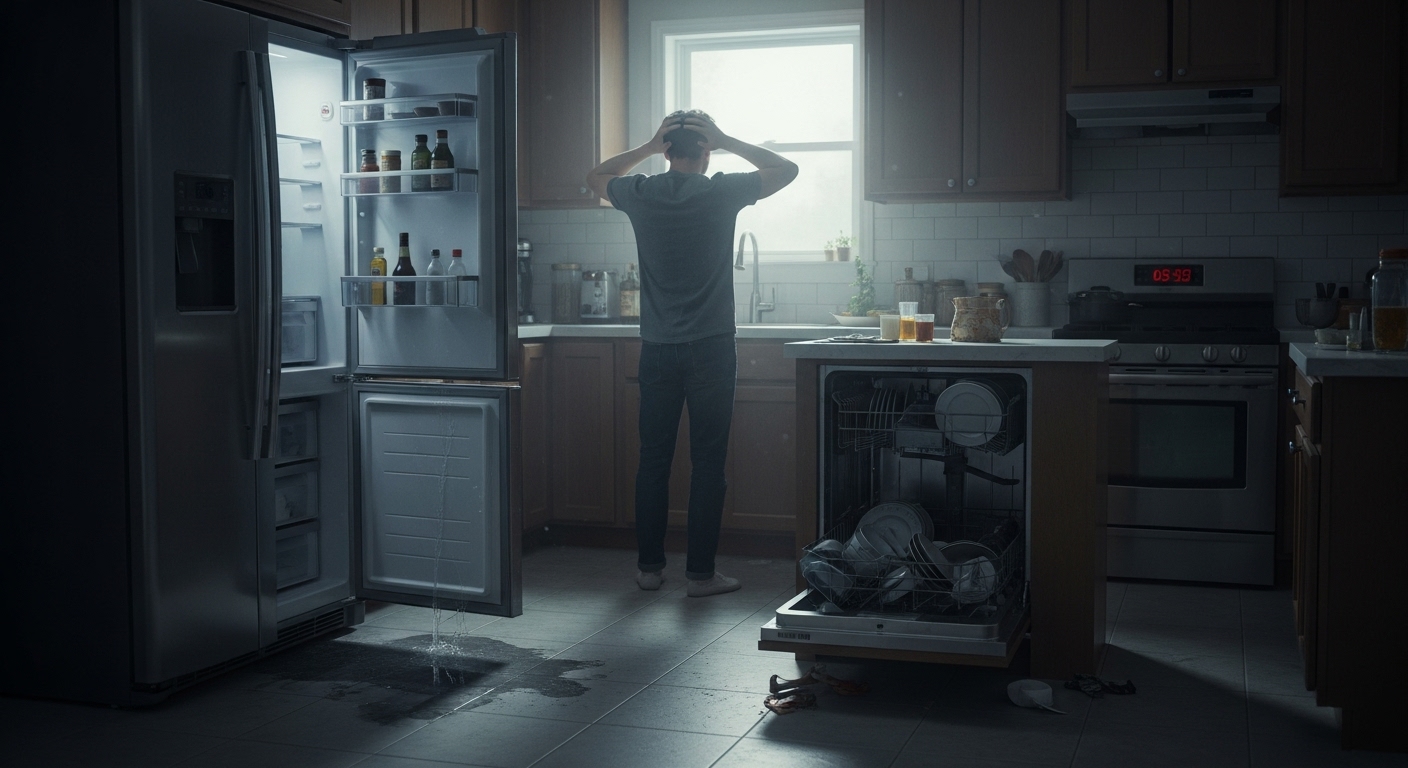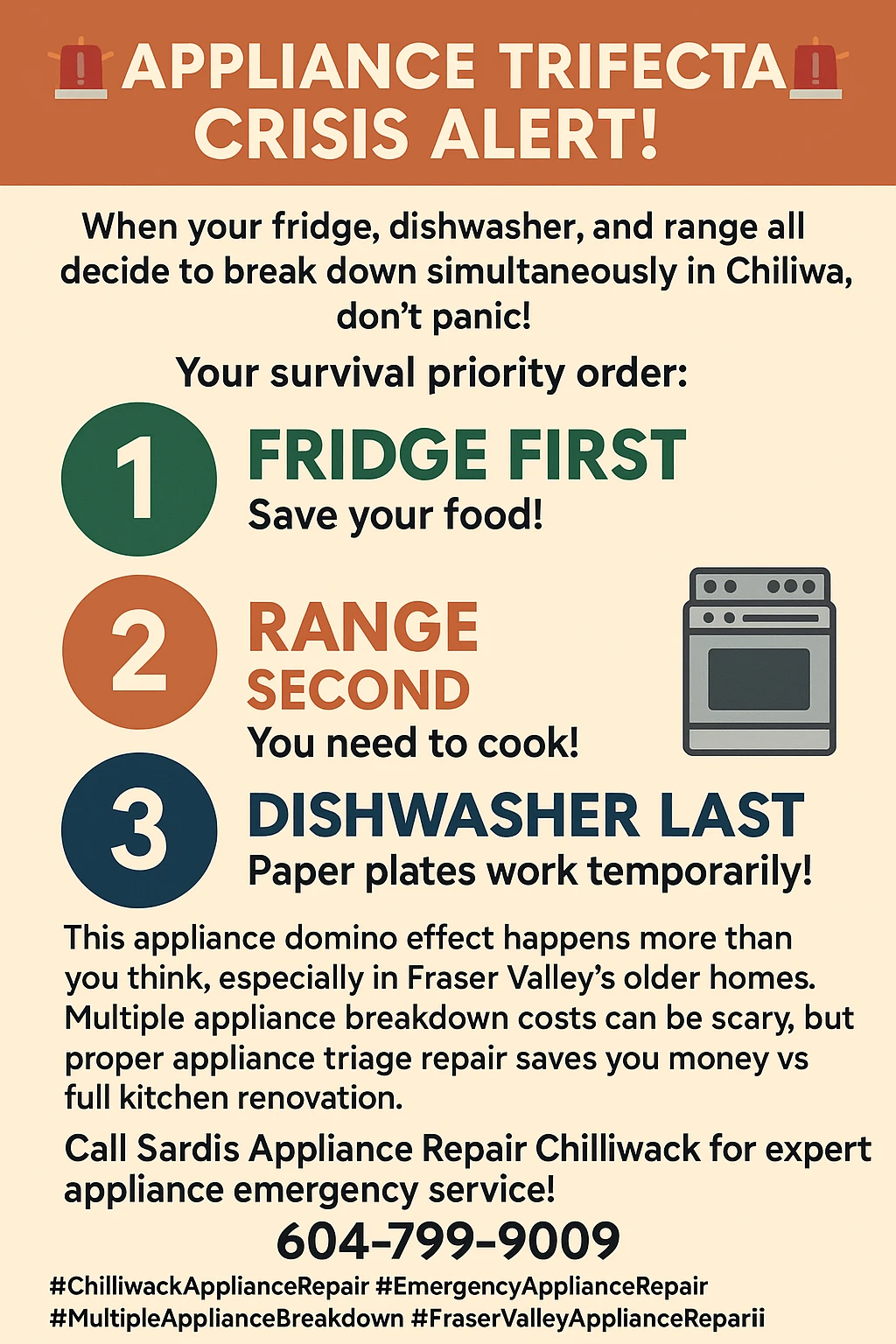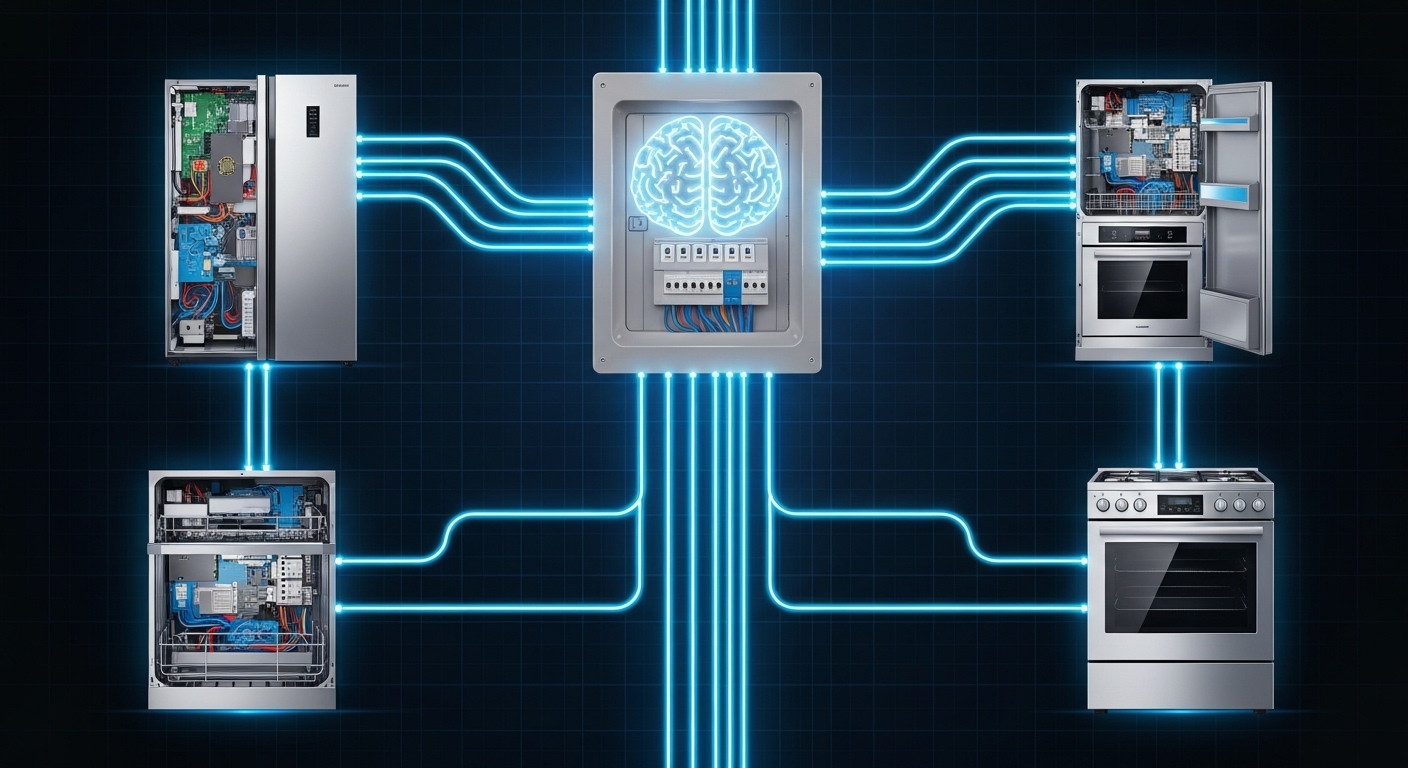Ever found yourself staring at a kitchen full of dead appliances, wondering if you’ve been cursed by the home improvement gods? Picture this: you wake up to a warm fridge, last night’s dishes still caked on plates because the dishwasher decided to take a permanent vacation, and your morning coffee plans are ruined because even the range won’t cooperate – welcome to the appliance trifecta crisis! Picture this nightmare scenario: you’re rushing to get breakfast ready for the family when you realize your coffee maker isn’t working. No big deal, you think, until you notice the fridge isn’t humming its usual tune, and those dishes from last night are still sitting dirty because your dishwasher has mysteriously gone silent too. Suddenly, you’re not dealing with one appliance hiccup – you’re facing a full-blown kitchen catastrophe that seems straight out of a homeowner’s horror story.  This isn’t just Murphy’s Law playing tricks on unsuspecting Chilliwack families. The phenomenon of multiple appliances failing simultaneously is more common than most people realize, and it usually has nothing to do with cosmic bad luck. Understanding why this happens and how to handle it can save you thousands of dollars, countless headaches, and maybe even your sanity during what feels like the worst possible timing. What makes this situation particularly stressful is the domino effect it creates throughout your daily routine. When your kitchen’s holy trinity of appliances decides to stage a coordinated rebellion, it doesn’t just disrupt meal prep – it throws your entire household schedule into chaos while potentially threatening your grocery budget through spoiled food and emergency takeout expenses.
This isn’t just Murphy’s Law playing tricks on unsuspecting Chilliwack families. The phenomenon of multiple appliances failing simultaneously is more common than most people realize, and it usually has nothing to do with cosmic bad luck. Understanding why this happens and how to handle it can save you thousands of dollars, countless headaches, and maybe even your sanity during what feels like the worst possible timing. What makes this situation particularly stressful is the domino effect it creates throughout your daily routine. When your kitchen’s holy trinity of appliances decides to stage a coordinated rebellion, it doesn’t just disrupt meal prep – it throws your entire household schedule into chaos while potentially threatening your grocery budget through spoiled food and emergency takeout expenses.
Key Takeaways
- Multiple appliance failures typically stem from electrical system issues rather than coincidental mechanical breakdowns, with GFCI breaker problems and power surges being the most common culprits
- Emergency response should prioritize electrical system diagnosis before individual appliance troubleshooting, potentially resolving multiple problems with a single repair
- Local Chilliwack services offer same-day emergency responses for appliance crises, with diagnostic costs ranging from $150-$240 for multiple appliances during a single visit
- Preventive maintenance programs cost approximately $395 annually but can reduce appliance failure rates by 60-70% compared to reactive repair approaches
- Strategic appliance replacement timing and electrical system upgrades provide long-term protection against future simultaneous failures while improving household resilience

Understanding the Appliance Trifecta Crisis Phenomenon
The simultaneous failure of your fridge, dishwasher, and range isn’t just cosmically bad timing – it’s actually a predictable pattern that reveals something much more significant about your home’s electrical infrastructure. When three major kitchen appliances decide to quit on the same day, experienced repair technicians don’t scratch their heads in amazement; they immediately start looking for the underlying electrical issue that’s almost certainly causing the problem. Think of your home’s electrical system as the nervous system of your house, with power flowing through interconnected circuits that serve multiple appliances. When something goes wrong with this electrical network, it doesn’t just affect one device – it can trigger a cascading failure that takes down everything connected to the affected circuits.  This is exactly what happens when a GFCI breaker trips and affects multiple kitchen and sunroom appliances simultaneously, creating what appears to be an impossible coincidence but is actually a single electrical event with multiple symptoms. Modern appliances are particularly vulnerable to these electrical disturbances because they’re packed with sophisticated electronic control systems, digital displays, and computerized modules that operate within very narrow voltage tolerances. Unlike the simple mechanical switches and timers found in older appliances, today’s smart refrigerators, programmable dishwashers, and digital ranges contain sensitive circuit boards that can be damaged or disrupted by power surges, voltage fluctuations, or electrical system failures. When these disturbances occur, they don’t discriminate – they affect every vulnerable appliance connected to the compromised electrical network. The interconnected nature of kitchen electrical circuits amplifies this problem because most kitchens share electrical loads across multiple circuits. Your refrigerator might be on one circuit, your dishwasher on another, and your range on a third, but they all depend on the same electrical panel and often share neutral wires or ground connections. When problems develop in the electrical panel or main service connections, the effects ripple through all connected circuits, potentially affecting multiple appliances that seem to be on completely separate electrical systems. This phenomenon has become increasingly common as homes pack more electronic appliances into kitchens that weren’t designed for such electrical demands. The average kitchen today contains twice as many electrical devices as kitchens from just twenty years ago, with each device containing more sophisticated electronics than entire houses once needed. This creates a perfect storm of high electrical demand, sensitive electronic components, and aging electrical infrastructure that can’t always handle the load.
This is exactly what happens when a GFCI breaker trips and affects multiple kitchen and sunroom appliances simultaneously, creating what appears to be an impossible coincidence but is actually a single electrical event with multiple symptoms. Modern appliances are particularly vulnerable to these electrical disturbances because they’re packed with sophisticated electronic control systems, digital displays, and computerized modules that operate within very narrow voltage tolerances. Unlike the simple mechanical switches and timers found in older appliances, today’s smart refrigerators, programmable dishwashers, and digital ranges contain sensitive circuit boards that can be damaged or disrupted by power surges, voltage fluctuations, or electrical system failures. When these disturbances occur, they don’t discriminate – they affect every vulnerable appliance connected to the compromised electrical network. The interconnected nature of kitchen electrical circuits amplifies this problem because most kitchens share electrical loads across multiple circuits. Your refrigerator might be on one circuit, your dishwasher on another, and your range on a third, but they all depend on the same electrical panel and often share neutral wires or ground connections. When problems develop in the electrical panel or main service connections, the effects ripple through all connected circuits, potentially affecting multiple appliances that seem to be on completely separate electrical systems. This phenomenon has become increasingly common as homes pack more electronic appliances into kitchens that weren’t designed for such electrical demands. The average kitchen today contains twice as many electrical devices as kitchens from just twenty years ago, with each device containing more sophisticated electronics than entire houses once needed. This creates a perfect storm of high electrical demand, sensitive electronic components, and aging electrical infrastructure that can’t always handle the load.
The Science Behind Simultaneous Appliance Failures
Moving beyond the surface-level frustration of multiple broken appliances, the technical reasons behind these simultaneous failures reveal fascinating insights about how modern homes actually function as complex electrical ecosystems. Understanding these underlying mechanisms helps homeowners recognize warning signs and take preventive action before minor electrical issues escalate into major appliance disasters. Power surges represent the most destructive and common cause of multiple appliance failures, with these electrical disturbances capable of traveling through your home’s wiring faster than you can blink. When lightning strikes nearby power lines, utility companies switch electrical loads, or large industrial equipment cycles on and off, the resulting voltage spikes can overwhelm the protective circuits within your appliances.  These surges don’t follow logical pathways – they can affect appliances throughout your home regardless of which specific circuits they’re connected to, explaining why homeowners often discover damage to appliances in completely different rooms. The vulnerability of contemporary appliances to electrical disturbances has increased dramatically with the integration of electronic control systems that manage everything from temperature regulation to cycle timing. Your grandmother’s refrigerator might have survived power surges that would instantly destroy a modern unit’s main control board, ice maker electronics, and digital temperature display. Today’s appliances contain circuit boards and electronic components that can be damaged by voltage fluctuations that wouldn’t even flicker a traditional incandescent light bulb, making them sitting ducks for electrical disturbances that older, simpler appliances would shrug off without missing a beat. Circuit overload conditions create another pathway for simultaneous appliance failures, particularly in older homes where electrical systems struggle to meet modern power demands. Kitchen appliances are among the highest electricity users in your home, with electric ranges drawing up to 50 amperes, dishwashers pulling 15-20 amperes during heating cycles, and refrigerators requiring dedicated circuits for optimal performance. When these power-hungry devices operate simultaneously on electrical systems designed for much lower loads, the resulting strain can manifest as circuit breaker trips that affect multiple appliance circuits at once. Temperature-related stress represents a more subtle but equally important factor in simultaneous appliance failures, particularly during extreme weather conditions. High ambient temperatures force appliances to work harder while simultaneously reducing the efficiency of their cooling systems, creating thermal stress that affects internal components. During summer heat waves, this thermal loading often coincides with increased electrical demand for air conditioning, creating compound stress on both individual appliances and the electrical systems that power them. The result can be multiple temperature-sensitive failures occurring within hours of each other. The aging factor plays a crucial multiplicative role in failure susceptibility, with appliances approaching their expected service lifetime becoming increasingly vulnerable to electrical disturbances that newer units would easily tolerate. Research indicates that washing machines and dishwashers exhibit multiple failure modes in approximately 25-30% of cases when they reach advanced age, suggesting that older appliances develop compound vulnerabilities that make them susceptible to simultaneous breakdown when subjected to any significant electrical stress. Load redistribution effects create cascading failure patterns that can turn single electrical problems into multiple appliance disasters through a domino effect of overloaded circuits. When one major appliance circuit fails, the electrical load typically redistributes to remaining circuits, potentially overloading systems that were already operating near capacity. This redistribution can trigger additional circuit failures, creating the cascading effect that characterizes appliance trifecta crises, where one initial problem triggers a chain reaction of subsequent failures throughout the electrical system.
These surges don’t follow logical pathways – they can affect appliances throughout your home regardless of which specific circuits they’re connected to, explaining why homeowners often discover damage to appliances in completely different rooms. The vulnerability of contemporary appliances to electrical disturbances has increased dramatically with the integration of electronic control systems that manage everything from temperature regulation to cycle timing. Your grandmother’s refrigerator might have survived power surges that would instantly destroy a modern unit’s main control board, ice maker electronics, and digital temperature display. Today’s appliances contain circuit boards and electronic components that can be damaged by voltage fluctuations that wouldn’t even flicker a traditional incandescent light bulb, making them sitting ducks for electrical disturbances that older, simpler appliances would shrug off without missing a beat. Circuit overload conditions create another pathway for simultaneous appliance failures, particularly in older homes where electrical systems struggle to meet modern power demands. Kitchen appliances are among the highest electricity users in your home, with electric ranges drawing up to 50 amperes, dishwashers pulling 15-20 amperes during heating cycles, and refrigerators requiring dedicated circuits for optimal performance. When these power-hungry devices operate simultaneously on electrical systems designed for much lower loads, the resulting strain can manifest as circuit breaker trips that affect multiple appliance circuits at once. Temperature-related stress represents a more subtle but equally important factor in simultaneous appliance failures, particularly during extreme weather conditions. High ambient temperatures force appliances to work harder while simultaneously reducing the efficiency of their cooling systems, creating thermal stress that affects internal components. During summer heat waves, this thermal loading often coincides with increased electrical demand for air conditioning, creating compound stress on both individual appliances and the electrical systems that power them. The result can be multiple temperature-sensitive failures occurring within hours of each other. The aging factor plays a crucial multiplicative role in failure susceptibility, with appliances approaching their expected service lifetime becoming increasingly vulnerable to electrical disturbances that newer units would easily tolerate. Research indicates that washing machines and dishwashers exhibit multiple failure modes in approximately 25-30% of cases when they reach advanced age, suggesting that older appliances develop compound vulnerabilities that make them susceptible to simultaneous breakdown when subjected to any significant electrical stress. Load redistribution effects create cascading failure patterns that can turn single electrical problems into multiple appliance disasters through a domino effect of overloaded circuits. When one major appliance circuit fails, the electrical load typically redistributes to remaining circuits, potentially overloading systems that were already operating near capacity. This redistribution can trigger additional circuit failures, creating the cascading effect that characterizes appliance trifecta crises, where one initial problem triggers a chain reaction of subsequent failures throughout the electrical system.
Immediate Response and Triage Strategies for Kitchen Appliance Emergencies
When you discover multiple appliances have failed simultaneously, your immediate response strategy can make the difference between a manageable inconvenience and a household disaster that costs thousands
 (604) 305-2992
(604) 305-2992 
 Schedule An Appointment
Schedule An Appointment 
